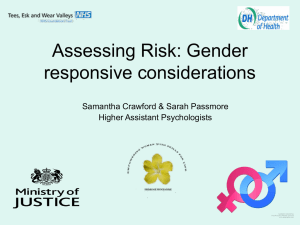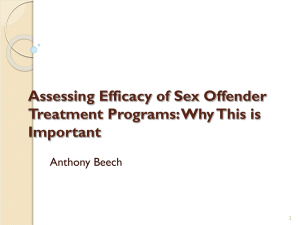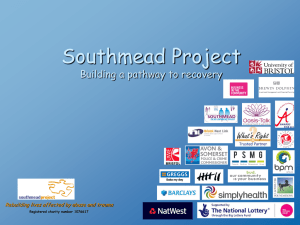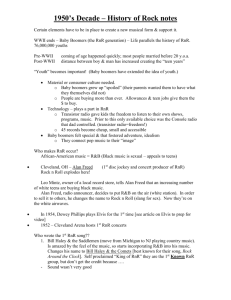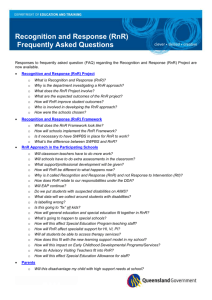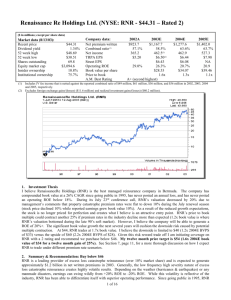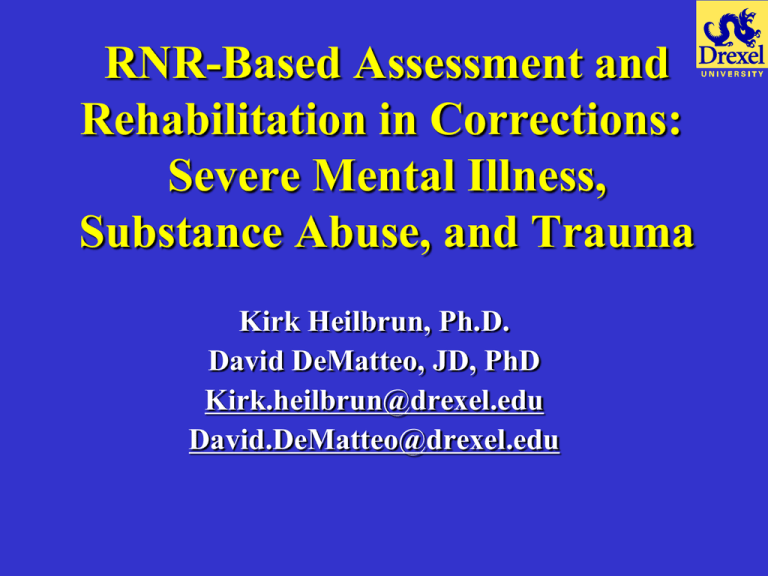
RNR-Based Assessment and
Rehabilitation in Corrections:
Severe Mental Illness,
Substance Abuse, and Trauma
Kirk Heilbrun, Ph.D.
David DeMatteo, JD, PhD
Kirk.heilbrun@drexel.edu
David.DeMatteo@drexel.edu
Presented for the Pennsylvania
DOC and Sponsored by
Community Education Centers
DOC Training Academy
Elizabethtown, PA
April 2011
Agenda
• Overview of RNR: Evidence and Implications (Heilbrun)
• RNR-Based Assessment & Treatment of Individuals w/
•Substance Abuse (DeMatteo)
•Severe Mental Illness (Heilbrun)
•Trauma Histories (DeMatteo)
•Small group exercise
Details
• Electronic version of handout available (RNR_
DOC_CEC_4_28_11)
• Electronic version of slides available
(RNR_DOC_CEC_slides_4_28_11)
• See
(http://www.drexel.edu/psychology/research/
labs/heilbrun/publications/)
4/9/2015
4
RNR Overview
• What is risk-need-responsivity?
– Model of correctional intervention based on the
factors of risk, need, and responsivity
– Risk factor
• Risk principle
– Need factor
• Need principle
– Responsivity factor
• General and specific responsivity
4/9/2015
5
RNR Overview
• Is there research supporting this model?
– Evidence that adherence to the model results in a
35% reduction in recidivism
– Meta-analyses
• RNR for adult, juvenile, violent, female, and sex
offenders
• Risk principle
4/9/2015
6
RNR Overview
• Other research support on
– RNR for different populations/programs
•
•
•
•
Community-based electronic monitoring
Substance abusing populations
Drug court
Prison-based programs
– Benefits of targeting high risk offenders
– Potential iatrogenic effects of interventions for
low-risk offenders
4/9/2015
RNR Overview
• How well are we doing with RNR?
– Studies of individual program adherence to RNR
show limited adherence in applied settings
• Inconsistencies in the research
– RNR more effective with certain populations (e.g.,
less supported among violent offenders in metaanalysis)
– Some studies have failed to find significant effects
4/9/2015
8
RNR Overview
• Gaps in the research
– Lack of research examining RNR on an individual
level
– Studies have started to look at the risk principle,
and generally find support for matching service
intensity to risk level
4/9/2015
9
RNR Overview
• Gaps in the research (cont.)
– Little research on “treatment fit,” or matching to
interventions based on needs
– Little research on specific responsivity
• There is value in assessing individual factors that may
influence how treatment succeeds, such as IQ, mental
illness, culture, motivation, and gender
4/9/2015
10
RNR Overview
• Problems in implementing RNR
– Not using up-to-date assessment tools
– Failure to base interventions on assessment results
– Lack of any risk/needs tools in intervention
process
– When risk/need information is available, it is
commonly not used effectively
4/9/2015
11
RNR Overview
• Guidelines for evidence-based RNR
– Administer a good risk/needs tool to identify risk
level and criminogenic needs
– Match offender into programs based on the
present needs
– Consider specific responsivity concerns, such as
gender, mental illness, trauma history
4/9/2015
12
RNR Overview
• RNR and Serious Mental Illness
– Offenders with serious mental illness generally
have the same risk factors as other offenders
– Evidence that providing mental health treatment
does not reduce recidivism
– Should focus on risk, need, responsivity factors
4/9/2015
13
Substance Abuse Overview
Scope of the Problem
• High rates of drug-involved criminal offenders
–
–
–
–
Arrestees (Mdn: 67% of males & 68% of females)
Inmates (80%)
Probationers (67%)
Parolees (80%)
• Strong relationship between drug use & crime
4/9/2015
14
Substance Abuse Overview
Scope of the Problem
• 80% of offenders report prior drug use
• 50% of state inmates meet criteria for drug
abuse/dependence (Karberg & James, 2005)
• But only 40% participate in drug treatment
while incarcerated (Mumola & Karberg, 2006)
4/9/2015
15
Substance Abuse Overview
Relapse & Recidivism
• 95% relapse rate within 3 years of release
• 50% recidivism rate within 1 year of release
• Within 3 years of release –
–
–
–
–
4/9/2015
68% re-arrested
47% re-convicted
25% re-sentenced for new crime
25% return to prison for testing drug-positive
16
Substance Abuse Overview
Public Safety vs. Public Health
• Public Safety
– In-prison treatment
– Intermediate sanctions
– Civil commitment
• Public Health
– Initiation
– Attrition
4/9/2015
17
Substance Abuse Assessment
Assessment Considerations
• Brief screen vs. in-depth assessment
• Psychometrically sound
• Assessment of individual risks & needs
• Assessment of multiple domains
4/9/2015
18
Substance Abuse Assessment
Assessment Considerations
• Ongoing assessment
• Administration time
• Interpretation by nonclinical staff
4/9/2015
19
Substance Abuse Assessment
Assessment Tools
• TCU Drug Screen
• Level of Service/Case Management Inventory
• Addiction Severity Index
• Global Assessment of Individual Needs
4/9/2015
20
Substance Abuse Assessment
Assessment Tools
• Substance Abuse Screening Instrument
• Offender Profile Index
• Substance Abuse Subtle Screening Inventory
4/9/2015
21
Substance Abuse Treatment
Intervention Considerations
• Client’s recognition of drug problem
• Motivation vs. coercion
• Matching services to needs
• High-risk vs. low-risk
• Recognizing diversity
4/9/2015
22
Substance Abuse Treatment
Intervention Considerations
• Comprehensive & evidence-based practices
• Medical care & medication
• Adaptive interventions
• Service integration & continuity of care
• Resources
4/9/2015
23
Substance Abuse Treatment
Correctional-based Interventions
• Increasing motivation
• Cognitive-behavioral therapy
• Substitution treatment
• Contingency management
4/9/2015
24
Substance Abuse Treatment
Correctional-based Interventions
• Case management
• Therapeutic communities
• Aftercare planning
4/9/2015
25
Substance Abuse Treatment
Community-based Interventions
• Restrictive Intermediate Punishment (RIP)
– Outpatient, halfway house, short-term
residential/detox, & long-term residential
– House offenders & monitor program compliance
• Diversion Programs
– Examples: drug courts, mental health courts, veterans
courts, re-entry courts
4/9/2015
26
Gender Differences in
Substance Abuse Treatment
• Increasing numbers of women are incarcerated
– From 1995-2005, female inmate population
increased 57%
– Since 1980, female inmate population has
increased 336%
• Most growth in inmate population is due to
drug-related offenses
4/9/2015
27
Gender Differences in
Substance Abuse Treatment
Female vs. Male Offenders
• Higher rates of (hard) drug use
• More physical health problems
• Higher rates of mental health problems
• History of victimization/abuse/trauma
4/9/2015
28
Gender Differences in
Substance Abuse Treatment
Female vs. Male Offenders
• Lower rates of employment
• Higher rates of financial difficulty
• Unhealthy social relationships
4/9/2015
29
Factors Influencing Re-arrest
• Predictors of re-arrest within 1 year
–
–
–
–
–
–
–
4/9/2015
Younger age
Fewer total days in aftercare
Longer lifetime incarceration
Co-occurring psychiatric disorder
Lower levels of education
Unemployment (males)
Parental responsibilities (females)
30
Severe Mental Illness:
Assessment
• Assessment of mental health problems
• Assessment of risk of violent and general
reoffending
4/9/2015
31
Mental Health Assessment
• Screen for mental health problems generally
• Specifically, screen for psychiatric symptoms,
substance abuse, and suicidality
• Incorporate information from a combination
of records review, interview, and self-report
inventories
4/9/2015
32
Risk Assessment
• Major predictors of general and violent
recidivism comparable for mentally disordered
and nondisordered offenders
• Psychopathology important in managing
mentally disordered offenders, but
• In terms of risk assessment, these clinical factors
are overshadowed by the more general factors
identified in the criminological research (Bonta,
Law, and Hanson, 1998)
4/9/2015
33
Risk Assessment
• A few specialized risk assessment tools have been
tested with mentally ill offenders, and perform
well enough to be used with this population
• Some of the tools are prediction-only tools (do not
identify targets for intervention); others are riskneed tools (do identify intervention targets)
4/9/2015
34
Risk Assessment
• Psychopathy Checklist (PCL)
– measures psychopathy, but performs
well in a risk assessment capacity
(prediction only)
• Violence Risk Appraisal Guide
(VRAG)
– prediction only
4/9/2015
35
Risk Assessment
• Level of Service (LS) inventories
– Risk-need
– Actuarial
• Historical, Clinical, Risk Management
(HCR-20)
– Risk-need
– Structured professional judgment
4/9/2015
36
Risk Assessment
• PCL, VRAG, and HCR-20 perform
comparably with mentally disordered
offenders (prediction)
• LS/CMI likely performs well with mentally ill
offenders (earlier LS tools have been found to
do so)
4/9/2015
37
Severe Mental Illness: Tx
• Evidence-based Interventions
• Cognitive Behavioral Therapy
• Dialectical Behavior Therapy
• Schema-focused Therapy
•
•
•
•
Group Psychotherapy
Suicide Risk Factors
Critical Time Intervention
Forensic Assertive Community Treatment
4/9/2015
38
Cognitive Behavioral Therapy
• CBT is structured approach focused on
symptoms, behavior and criminogenic needs
• Offenders w/SMI have criminogenic needs
associated with values, beliefs, thinking styles,
and cognitive emotional states
• Identifying , disputing automatic thoughts that
generate symptoms (e.g., anxiety, depression)
results in improvement
4/9/2015
39
CBT Examples
– Thinking for a Change – problem-solving approach
using introspection, cognitive restructuring, and
social skills training
– Lifestyle Change – teaches cost-benefit analysis of
choices and consequences; focuses on thinking
styles associated with criminal activity
– Reasoning & Rehabilitation – targets cognitive
processing and pro-criminal thinking
4/9/2015
40
CBT
• CBT reduced odds of recidivism by 1.5 in 12
months after intervention (Landerbergery & Lipsey, 2005)
• Important factors in reducing recidivism:
– Initial risk level
– How well treatment implemented
– Inclusion of anger control and interpersonal
problem-solving
4/9/2015
41
Dialectical Behavior Therapy
• Effective with behavioral dyscontrol (e.g., selfharm, violence, poor impulse control)
• Goals:
– Improve emotional modulation
– Increase awareness of consequences to others
• Skills training may emphasize emotional
regulation and distress tolerance
4/9/2015
42
Schema-Focused Therapy
• SFT focuses on maladaptive schemas (fixed
patterns of thoughts, feelings, and behaviors
from negative childhood experiences that
continue into adulthood)
• Implemented in forensic settings for those with
severe APD and/or psychopathy (Bernstein, 2007)
4/9/2015
43
Group Psychotherapy
• May result in improvements in institutional
adjustment, anger, anxiety, depression,
interpersonal relations, and self esteem
• Incorporation of cognitive and behavioral
approaches enhances results
• Improvements may not depend on whether
inmates were mandated or self-referred
4/9/2015
44
Suicide Risk Factors
• Environmental
– Being in isolation or segregation cells
– Shifts with reduced staffing
• Distal
– Poor social and family support
– Prior suicidal behavior (esp within last 1-2 years)
– Hx of psychiatric illness, emotional problems
4/9/2015
45
Suicide Risk Factors (cont.)
• Proximal
– Hopelessness
– Narrowing of future prospects
– Loss of options for coping
– Feeling of being bullied
– Suicidal intent or plans
4/9/2015
46
Critical Time Intervention
• Two main components:
– Strengthen long-term ties to community and
family/friends
– Provide emotional and practical support
and advocacy during critical time of
transition
4/9/2015
47
Critical Time Intervention (cont)
• Core elements
– small caseloads, individualized case management
– community outreach
– psychosocial skills building, motivational coaching
• Context of reentry:
– Social ties (e.g., housing, employment, education)
– Makes use of existing social connections
4/9/2015
48
FACT
• FACT (“Forensic ACT Team”) focuses
on keeping those with SMI out of
jails/prisons
• Team of professionals provide services
based on consumer needs
4/9/2015
49
FACT
• Elements
– Goal : preventing (re)arrest and (re)incarceration
– Those on team of service-providers may have
criminal justice histories
– Majority of referrals from justice agencies
– Supervised residential tx component for high-risk
consumers, esp those with substance-use disorders
4/9/2015
50
Trauma History
• Definition of Trauma
– Direct exposure to extreme stressor
– Actual or threatened death/serious injury/threat of
injury
– Witnessing death/injury/threat of injury to others
– Learning about unexpected or violent death,
serious harm or threat of death or injury to family
member close friend
– Marked by intense fear and helplessness
4/9/2015
51
Considering Trauma History
• Adverse Childhood Experiences (ACE) Study
– Examined relationship between adult health risk
& exposure to childhood emotional/physical/sexual
abuse & household dysfunction during childhood
– Those with four or more categories of childhood
exposure had increased health risks
4/9/2015
52
Considering Trauma History
• Messina & Grella (2006)
– Examined 500 women in Female Offender
Treatment and Employment Program
– Found similar results to ACE study
4/9/2015
53
Trauma Triad
• Re-living, re-experiencing, and intrusive
memories
• Hyper-arousal, hyper-vigilance, intense
physiological distress and reactivity
• Dissociation avoidance and numbing
4/9/2015
54
4/9/2015
55
Trauma Informed Care
• Incorporates knowledge about trauma in all
aspects of service
• Creates environment that is hospitable, engaging,
& minimizes re-victimization
• Goals: empowerment and recovery
• Recognize strengths of survivors & recovery/
healing needs of survivors
4/9/2015
56
Important Principles of
Trauma Informed Care
•
•
•
•
•
Safety
Trustworthiness
Choice
Collaboration
Empowerment
4/9/2015
57
Examples of Trauma Specific
Treatment Approaches
• Seeking Safety
• Trauma Recovery and Empowerment
(TREM)
• Atrium
• Triad
4/9/2015
58
Small Group Exercise
• Considering your present unit(s) and caseload:
– How would you change current practice to reflect
today’s material?
– If practice were changed in this way, how well
would it address the mental health needs of those
on your caseload?
– How well would it address the criminogenic needs?
4/9/2015
59






